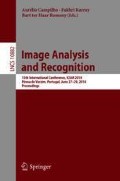Abstract
In this work, we present a deep learning framework for multi-class breast cancer image classification as our submission to the International Conference on Image Analysis and Recognition (ICIAR) 2018 Grand Challenge on BreAst Cancer Histology images (BACH). As these histology images are too large to fit into GPU memory, we first propose using Inception V3 to perform patch level classification. The patch level predictions are then passed through an ensemble fusion framework involving majority voting, gradient boosting machine (GBM), and logistic regression to obtain the image level prediction. We improve the sensitivity of the Normal and Benign predicted classes by designing a Dual Path Network (DPN) to be used as a feature extractor where these extracted features are further sent to a second layer of ensemble prediction fusion using GBM, logistic regression, and support vector machine (SVM) to refine predictions. Experimental results demonstrate our framework shows a 12.5\(\%\) improvement over the state-of-the-art model.
Access this chapter
Tax calculation will be finalised at checkout
Purchases are for personal use only
References
U.S. Cancer Statistics Working Group: United States Cancer Statistics: 1999–2014 Incidence and Mortality Web-based Report. U.S. Department of Health and Human Services, Centers for Disease Control and Prevention and National Cancer Institute, Atlanta (2017). www.cdc.gov/uscs
Saadatmand, S., et al.: Influence of tumour stage at breast cancer detection on survival in modern times: population based study in 173 797 patients. Bmj 351, h4901 (2015)
Berry, D.A., et al.: Effect of screening and adjuvant therapy on mortality from breast cancer. New Engl. J. Med. 353(17), 1784–1792 (2005)
de Gelder, R., et al.: The effects of population-based mammography screening starting between age 40 and 50 in the presence of adjuvant systemic therapy. Int. J. Cancer 137(1), 165–172 (2015)
Hadjiiski, L., et al.: Advances in CAD for diagnosis of breast cancer. Curr. Opin. Obstet. Gynecol. 18(1), 64 (2006)
Elmore, J.G., et al.: Diagnostic concordance among pathologists interpreting breast biopsy specimens. Jama 313(11), 1122–1132 (2015)
Macenko, M.: A method for normalizing histology slides for quantitative analysis. In: IEEE International Symposium on Biomedical Imaging: From Nano to Macro, ISBI 2009. IEEE (2009)
Vahadane, A., et al.: Structure-preserved color normalization for histological images. In: 2015 IEEE 12th International Symposium on Biomedical Imaging (ISBI). IEEE (2015)
Wang, D., et al.: Deep learning for identifying metastatic breast cancer. arXiv preprint arXiv:1606.05718 (2016)
Liu, Y., et al.: Detecting cancer metastases on gigapixel pathology images. arXiv preprint arXiv:1703.02442 (2017)
Araújo, T., et al.: Classification of breast cancer histology images using convolutional neural networks. PloS one 12(6), e0177544 (2017)
Nayak, N., et al.: Classification of tumor histopathology via sparse feature learning. In: 2013 IEEE 10th International Symposium on Biomedical Imaging (ISBI). IEEE (2013)
Gorelick, L., et al.: Prostate histopathology: learning tissue component histograms for cancer detection and classification. IEEE Trans. Med. Imaging 32(10), 1804–1818 (2013)
Xu, Y., et al.: Weakly supervised histopathology cancer image segmentation and classification. Med. Image Anal. 18(3), 591–604 (2014)
Ciompi, F., et al.: The importance of stain normalization in colorectal tissue classification with convolutional networks. arXiv preprint arXiv:1702.05931 (2017)
Hou, L., et al.: Patch-based convolutional neural network for whole slide tissue image classification. In: Proceedings of the IEEE Conference on Computer Vision and Pattern Recognition (2016)
Bejnordi, B.E., et al.: Diagnostic assessment of deep learning algorithms for detection of lymph node metastases in women with breast cancer. Jama 318(22), 2199–2210 (2017)
Szegedy, C., et al.: Going deeper with convolutions. In: CVPR (2015)
Otsu, N.: A threshold selection method from gray-level histograms. IEEE Trans. Syst. Man Cybern. 9(1), 62–66 (1979)
Wang, W., et al.: Detection and classification of thyroid follicular lesions based on nuclear structure from histopathology images. Cytom. Part A 77(5), 485–494 (2010)
Bejnordi, B.E., et al.: Stain specific standardization of whole-slide histopathological images. IEEE Trans. Med. Imaging 35(2), 404–415 (2016)
Khan, A.M., et al.: A nonlinear mapping approach to stain normalization in digital histopathology images using image-specific color deconvolution. IEEE Trans. Biomed. Eng. 61(6), 1729–1738 (2014)
Chen, Y., et al.: Dual path networks. In: Advances in Neural Information Processing Systems (2017)
Zhu, W., et al.: DeepLung: deep 3D dual path nets for automated pulmonary nodule detection and classification. In: IEEE WACV (2018)
Zhu, W., Lou, Q., Vang, Y.S., Xie, X.: Deep multi-instance networks with sparse label assignment for whole mammogram classification. In: Descoteaux, M., Maier-Hein, L., Franz, A., Jannin, P., Collins, D.L., Duchesne, S. (eds.) MICCAI 2017. LNCS, vol. 10435, pp. 603–611. Springer, Cham (2017). https://doi.org/10.1007/978-3-319-66179-7_69
Zhu, W., et al.: Adversarial deep structured nets for mass segmentation from mammograms. In: IEEE ISBI (2018)
Author information
Authors and Affiliations
Corresponding author
Editor information
Editors and Affiliations
Rights and permissions
Copyright information
© 2018 Springer International Publishing AG, part of Springer Nature
About this paper
Cite this paper
Vang, Y.S., Chen, Z., Xie, X. (2018). Deep Learning Framework for Multi-class Breast Cancer Histology Image Classification. In: Campilho, A., Karray, F., ter Haar Romeny, B. (eds) Image Analysis and Recognition. ICIAR 2018. Lecture Notes in Computer Science(), vol 10882. Springer, Cham. https://doi.org/10.1007/978-3-319-93000-8_104
Download citation
DOI: https://doi.org/10.1007/978-3-319-93000-8_104
Published:
Publisher Name: Springer, Cham
Print ISBN: 978-3-319-92999-6
Online ISBN: 978-3-319-93000-8
eBook Packages: Computer ScienceComputer Science (R0)

